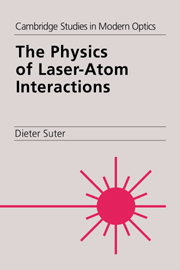Book contents
- Frontmatter
- Contents
- Preface
- Symbols and abbreviations
- 1 Introduction
- 2 Two-level atoms
- 3 Three-level effects
- 4 Internal degrees of freedom
- 5 Optical pumping
- 6 Optically anisotropic vapours
- 7 Coherent Raman processes
- 8 Sublevel dynamics
- 9 Two-dimensional spectroscopy
- 10 Nonlinear dynamics
- 11 Mechanical effects of light
- References
- Index
6 - Optically anisotropic vapours
Published online by Cambridge University Press: 13 October 2009
- Frontmatter
- Contents
- Preface
- Symbols and abbreviations
- 1 Introduction
- 2 Two-level atoms
- 3 Three-level effects
- 4 Internal degrees of freedom
- 5 Optical pumping
- 6 Optically anisotropic vapours
- 7 Coherent Raman processes
- 8 Sublevel dynamics
- 9 Two-dimensional spectroscopy
- 10 Nonlinear dynamics
- 11 Mechanical effects of light
- References
- Index
Summary
From a macroscopic viewpoint, atomic vapours appear homogeneous and isotropic. As we have seen during the discussion of the microscopic dynamics that light induces in atomic systems, however, the interaction with light as well as external fields can break the rotational and translational symmetries and make the system both inhomogeneous and anisotropic. This microscopic anisotropy appears directly in the optical properties of the system. This chapter discusses the propagation of light in such a medium and describes experiments that analyse the transmitted light to obtain information about the microscopic state of the medium.
Isotropic atoms
The Lorentz–Lorenz model
Outline
The interaction of electromagnetic radiation with matter, in particular light, has inspired philosophers of nature for many centuries and has led to heated debates like the one between Newton and Goethe. The original interest was with the difference in absorption of various materials as a function of the optical wavelength and with the refraction of light, i.e., its dispersion.
The first theoretical analysis that connected these macroscopic effects to microscopic properties of the material was the Lorentz–Lorenz theory of dispersion (Lorentz 1880; Lorenz 1881), which was put forward shortly after the Maxwell equations and published in the year after Maxwell's death. (See Figure 6.1.) This theory models the material as a collection of dipoles, driven by the electromagnetic wave. We give here a brief summary of the theory, since its physical content is still the foundation of today's description although the mathematical formalism has changed significantly.
- Type
- Chapter
- Information
- The Physics of Laser-Atom Interactions , pp. 203 - 247Publisher: Cambridge University PressPrint publication year: 1997



